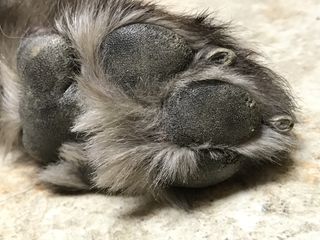Anxiety
The True Cost of a Nail Trim
Why you, the dog owner, should be taking over nail trims from your veterinarian
Posted November 22, 2017

News flash!
Dogs. Do. Not. Like. Nail. Trims.
Shocking, right?
Not really. Most people understand this intuitively from watching the shenanigans ensue as soon as a vet tech or groomer puts a dog on a table and grabs a nail trimmer.
As a veterinary behaviorist, I’ve seen plenty of fearful and/or aggressive patients get worse after poorly handled nail trims and grooms. Let’s stop scaring our friends. Scared dogs are more likely to bite people, and we’ve already got plenty of public health risks to go around (dietary sodium levels, sugary soda, water quality, etc., etc.)
Thankfully, nail trims are generally not medical procedures. You can, and should, learn to do them at home. But they are extremely important. With untrimmed nails, animals can snag or even rip their claws. More insidiously, long nails can make animals walk and stand abnormally, turning otherwise tiny problems into big deals. Long nails can make animals slip on flooring, and that in turn can make them more anxious and less willing to move or play. In short, nail care is key for animal health and welfare.
The problem is that good nail trims may or may not be fast, but clients often expect that they should be. This is likely because, for eons, veterinary clinics have offered this frequently performed technical procedure either free or below-cost. As a result, clients often think of nail trims as a “quick” or “add-on” service that barely even needs an appointment.
This pressures veterinarians to squeeze nail trims in, even when it’s not urgent for the animal and disrupts the hospital schedule. Why? Because veterinarians like to accommodate clients if possible. This is customer service and medicine. And it’s tricky to combine the two well.
In addition, only a modest percentage of owners and veterinarians understand and take appropriate action when common stress signals and signs of fear pop up. Poorly handled nail trims are not good for your dog in the long run. Repeated bad experiences at the veterinary clinic can make your dog hate the vet, which will make it hard to provide excellent medical care in the future. And if your dog already has any underlying fear of people or handling, poorly done nail trims can escalate these fears and cause previously non-aggressive dogs to growl, snarl, snap, and/or bite.
To avoid the escalation of fear, anxiety, and stress related to nail trims, we first need to get clients and veterinarians on the same page. So I did an informal survey of veterinarians and clients to clear up some common misconceptions.
Here’s the skinny.
VETS WANT YOU TO KNOW
The ability or willingness of your vet to do a nail trim on a fearful and/or aggressive dog without sedation or anti-anxiety medication is not a reflection on you as an owner or them as veterinarians. In fact, knowledgeable, ethical veterinarians will strongly encourage a variety of alternatives or alterations to the traditional nail trim for all patients who find nail trims stressful.
She/he will use special foods, soft surfaces, music, gentle touch, and a strong background in body language to assess your dog’s comfort. The staff will provide restraint only as absolutely needed, and will never do a nail trim with “brutocaine” (vet slang for intense bodily restraint, often with multiple people). If your dog is distressed for more than a few tries or a few seconds and can’t get comfortable, your vet might recommend testing anti-anxiety medications and trying again another day. Your vet is not trying to inconvenience you, even though this approach may stick it to your schedule.
This is the best medicine. Listen to your vet.
A terrible vet isn’t going to offer these options. A lazy vet is just going to have staff barrel through a nail trim even when doing so risks complicating medical care in the future and doing damage to your animal’s behavior at home.
Thankfully, most vets are neither terrible nor lazy, but they are concerned about what you think. Perceived or actual client pressure may make some good vets go, go, go when they should stop. The vast majority of veterinarians will stop a nail trim or other handling procedure on a dime if they know that’s what a client prefers.
CLIENTS WANT VETS TO KNOW
Dogs are often fearful during nail trims. Even a dog who’s less wiggly or aggressive when in the “back” without family members may not be less fearful. Instead, he or she may just be in the “freeze” mode of “fight, flight, or freeze.” Vets who keep going after a dog freezes increase the risk the dogs will become more frightened and potentially aggressive, not only at the veterinary clinic but in regular life as well.
Please tell your client if a dog is having trouble with nail trims. Since these are often done out of client sight, they may not know.
If a pet is having troubles with nail trims, please provide specific resources and training on how to teach the dog to tolerate or like it.
Continue to encourage clients with new puppies to teach puppies early to enjoy having their feet handled and like having nail trims. This is an important part of at-home dog care, and some families don’t know how important it is.
The Great News for Vets and Families
While nail trimming is a technical skill, most people and their dogs find it easy to learn! Most dogs can learn to tolerate and even like nail trims, as long as everyone who works with the dog’s feet knows how to make it a pleasant experience.
Let’s move the humble, and behaviorally risky, nail trim back home. Here are some resources to get everyone started! Happy Trimming!
Fear FreeTM www.fearfreepets.com
-You can find certified veterinarians, groomers, and trainers at this site.
The Bucket Game from Chirag Patel at Domesticated Manners
https://www.youtube.com/watch?v=GJSs9eqi2r8
-A great technique for learning about cooperative care with your dog.
Nail Maintenance for Dogs Face Book Group
-Find a community of like-minded friendly dog folks who really want to help each other find ways of making nail trims more fun for everyone.
E'Lise Christensen, DVM DACVB




